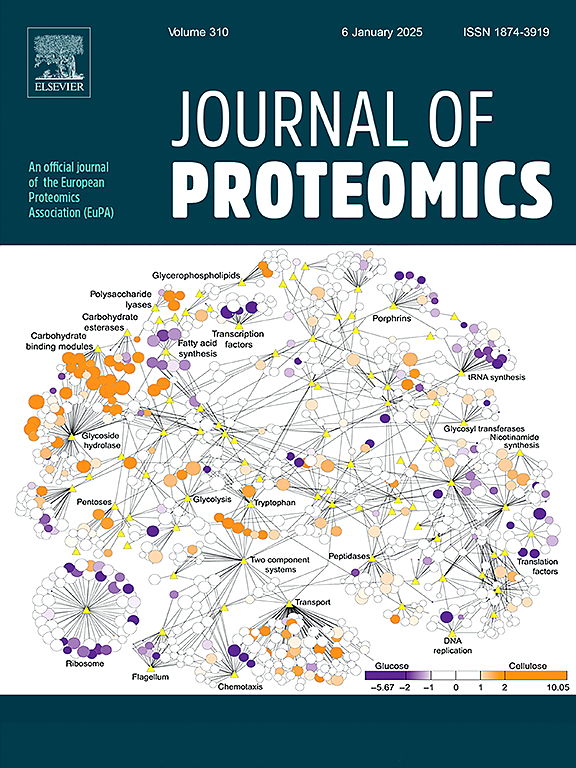Proteomic analysis reveals differentially abundant proteins involved in post-pollination responses to heat stress in Brassica napus
IF 2.8
2区 生物学
Q2 BIOCHEMICAL RESEARCH METHODS
引用次数: 0
Abstract
Heat stress significantly reduces canola seed production during the post-pollination stages. This study explored changes in the proteome of flowers on the main stem of three Brassica napus cultivars exposed to transient heat stress after pollination. Flowers at the 2nd to 5th reproductive nodes on the main stem were collected on days 0, 1, 3 and 6 of heat stress and control treatments. The three cultivars, Alku, AV-Ruby, and YM11, exhibited varying degrees of heat sensitivity and resilience based on seed production in pods at these reproductive nodes. The seed yield per pod under heat stress was 75.3 % of the control in Alku and 64.2 % in YM11. However, AV-Ruby retained 93.5 % of its seed yield under heat stress, from which we conclude AV-Ruby was more resilient to heat stress during the post-pollination stage than Alku or YM11. There were 474 differentially abundant proteins (DAPs) identified across all cultivars and time points. Among the DAPs, two HSP20-like chaperones (A0A078I8F7, A0A078JBL3) and one HSP-related protein (A0A078JJT8) were consistently highly abundant under heat and were strong candidates as heat responsive proteins. Pathways related to maintaining membrane integrity were specifically enriched in AV-Ruby, and deserve further study for their potential involvement in heat tolerance.
Significance of the study
Heat stress is a major factor threatening seed yield in cool season crops including oilseed rape, particularly during the post-pollination stages when pollination, fertilization, and embryo development are highly vulnerable to elevated temperatures. A comparative proteomic analysis was carried out to identify heat-responsive proteins during the post-pollination period. Among the DAPs, three were consistently associated with heat stress response. A range of biological processes, including protein folding and stress signalling, were involved in a general response to heat stress in all cultivars. Furthermore, pathways related to maintaining membrane integrity were specifically enhanced in a heat-resilient cultivar. These findings provide new insights into the heat response at the protein level and lay the groundwork for identifying potential molecular targets for breeding heat-tolerant oilseed rape cultivars.

蛋白质组学分析揭示了甘蓝型油菜授粉后对热胁迫反应的差异丰富蛋白。
在授粉后阶段,热胁迫显著降低了油菜籽的产量。本研究探讨了三种甘蓝型油菜在授粉后短暂热胁迫下主茎花蛋白质组的变化。分别在热胁迫和对照处理的第0、1、3、6天采集主茎第2 ~ 5生殖节的花。Alku、AV-Ruby和YM11三个品种在这些生殖节点上的荚果产量表现出不同程度的热敏性和恢复力。热胁迫下Alku和YM11的单荚种子产量分别为对照的75.3 %和64.2 %。然而,AV-Ruby在热胁迫下仍能保持93.5 %的种子产量,由此我们得出AV-Ruby在授粉后阶段比Alku或YM11更能适应热胁迫。在所有品种和时间点鉴定出474个差异丰富蛋白(DAPs)。在这些DAPs中,两种hsp20样伴侣蛋白(A0A078I8F7、A0A078JBL3)和一种hsp20相关蛋白(A0A078JJT8)在高温下持续高丰度,是热响应蛋白的有力候选蛋白。AV-Ruby特异性地富集了与维持膜完整性相关的通路,它们在耐热性中的潜在参与值得进一步研究。研究意义:热胁迫是包括油菜在内的冷季作物种子产量的主要威胁因素,特别是在授粉后阶段,授粉、受精和胚胎发育对高温非常敏感。通过比较蛋白质组学分析,鉴定了授粉后的热响应蛋白。在dap中,有三个与热应激反应一致。包括蛋白质折叠和胁迫信号在内的一系列生物过程参与了所有品种对热胁迫的一般反应。此外,与维持膜完整性相关的途径在耐热品种中得到了特异性增强。这些发现为在蛋白质水平上研究热响应提供了新的思路,并为寻找耐热油菜品种的潜在分子靶点奠定了基础。
本文章由计算机程序翻译,如有差异,请以英文原文为准。
求助全文
约1分钟内获得全文
求助全文
来源期刊

Journal of proteomics
生物-生化研究方法
CiteScore
7.10
自引率
3.00%
发文量
227
审稿时长
73 days
期刊介绍:
Journal of Proteomics is aimed at protein scientists and analytical chemists in the field of proteomics, biomarker discovery, protein analytics, plant proteomics, microbial and animal proteomics, human studies, tissue imaging by mass spectrometry, non-conventional and non-model organism proteomics, and protein bioinformatics. The journal welcomes papers in new and upcoming areas such as metabolomics, genomics, systems biology, toxicogenomics, pharmacoproteomics.
Journal of Proteomics unifies both fundamental scientists and clinicians, and includes translational research. Suggestions for reviews, webinars and thematic issues are welcome.
 求助内容:
求助内容: 应助结果提醒方式:
应助结果提醒方式:


